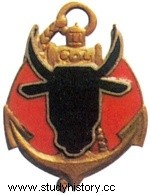
In small groups or individually, French officers and non-commissioned officers were
sent to India and were integrated into the French "Service Action", which worked closely with "force 136".
This s force 136", dependent on the Special opera-rions executive, whose P.C. is in London, has the responsibility of the clandestine action in the territories of Asia occupied by the Japanese.
The French who arrived in this way were immediately sent to the training camps of the "force 136" in the midst of strict precautionary measures taken to prevent the numerous Indian agents working for the Japanese from discovering their nationality.
Japanese espionage is active and anything that could possibly compromise what is being prepared in French Indochina must be avoided. These men who arrive will, in fact, have to be smuggled there to familiarize the army of Indochina with the weapons and equipment which will be parachuted to it, to prepare clandestine landing grounds and dropping zones, to set up maquis, caches of arms and equipment... and, on D-Day, wage guerrilla warfare against the occupier in connection with the major land offensives planned by the Allies in Southeast Asia.
The first to arrive choose, as their emblem, the head of a gaur, an Asian ox, common in Indochina and whose qualities agree so well with those required of commandos:vigor, strength, calm, speed of execution.
Selected for their knowledge of the Far East, their military qualities, their habit of the jungle, the "Gaurs" include a large proportion of reservists.
Barely dressed in the officers' shops of the British army in India — light shirts and shorts, felt hats with the "Gaurs" crest — all these men were dispatched to their first destination:Poona, in the country of the Mahrattas, in South India.
The training begins sometimes on the shores of a lake some twenty kilometers west of Poona, sometimes in the old fort of Singarh, on the foothills of the Western Ghats which dominate the plain for a few hundred meters. This first course is primarily a physical and moral test and includes exercises corresponding to the standards of British commandos.
The program essentially includes:physical development, endurance for walking and the difficulties of the jungle , sabotage and traps, commando tactics, boat handling, swimming, shooting, orientation and topography, knowledge of the Japanese army and its weapons, silent killing, interpretation of aerial photos, hygiene and first aid...
